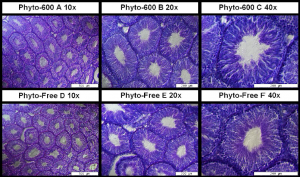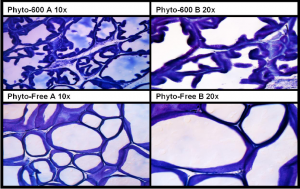Trevor Hansen and Dr. Edwin Lephart, Physiology and Developmental Biology
Phytoestrogens are estrogen-like molecules derived from soy-based foodstuffs such as soybeans, tofu and even certain cereals. In particular, our study focused on a subclass of phytoestrogens called isoflavones. Of the many isoflavones, daidzene and genistein are thought to exert the most potent estrogenic hormone activity, and thus have been the subject of much recent research.
Estrogens are typically associated with female development, yet they are known to exert significant effects in males as well. The purpose of our research was to determine what types of effects a high soy content diet would have on the sexual development of male rats between birth and 100 days old. The rats in our study were placed on a strict diet of either high-phytoestrogen or low-phytoestrogen food pellets from birth. In addition, the parental rats were also kept on the same diets, and were mated within their respective groups. This ensured that each rat would have prenatal, lifelong exposure to only one of the two diets. At 100 days of age, the rats were sacrificed and we collected data regarding their total body weight, adipose tissue, and testicular and prostate size and morphology. From these results, we were able to draw conclusions regarding phytoestrogen effects on sexual health parameters in rats.
When compared against the low-phytoestrogen group, the rats fed a high soy diet exhibited significantly lower white adipose tissue. In addition, they trended towards lower overall body weight. The effects of estrogen on rat and human weight have been well documented in the past by several researchers. In addition, these rats possessed significantly larger testes by weight, and further study showed these changes to continue through many of the large structures that make up the testes. In particular, stained cross-sections taken from the rats fed high soy diets showed increased sertoli cell area, seminiferous tubule area, and lumen area when compared to the rats fed a low-soy diet.

The implications include a possible increase in sperm production and storage, which in turn could indicate greater fertility.
We also compared prostate size and morphology between the treatment groups, and found a trend towards lower prostate weight in the high-soy rats. As men increase in age, prostate-related problems become an increasing concern. Benign prostate hyperplasia (BPH), prostatitis and prostate cancer are all conditions that seriously affect the lives of many men. Though our study ended before we more data could be garnered, we believe that testing these rats over a full lifetime on the high-phytoestrogen diet would have produced a significant difference between prostate size for the two groups. Similar to the testes, closer observation of stained sections showed a difference in the morphology of the prostates from the different groups.

Rats fed the phytoestrogen-high diet had a greater percentage of involuted glands, contributing to the observed decrease in weight and size. If this decrease in prostate size and development is, indeed, a lifelong byproduct of soy consumption, it could have benefits as an alternative treatment to the afore mentioned prostate conditions. Be ameliorating even a few of the associated symptoms, soy has the potential to increase the quality of life for countless men.
Though our research is far from completed in regards to phytoestrogen effects on male sexual parameters, we have made measurable progress into further understanding the effects of these molecules on the body. Perhaps, at some future date, the science will grow to include human observational studies. For now, the next test that needs attention will include keeping male rats on phytoestrogen diets for the full duration of their lives, thereby enabling us to examine soy effects during the period of life when prostate and testicular problems arise. If such studies return successful, as well as subsequent studies into the efficacy in humans, perhaps one day estrogen therapy will not only be a female treatment.
